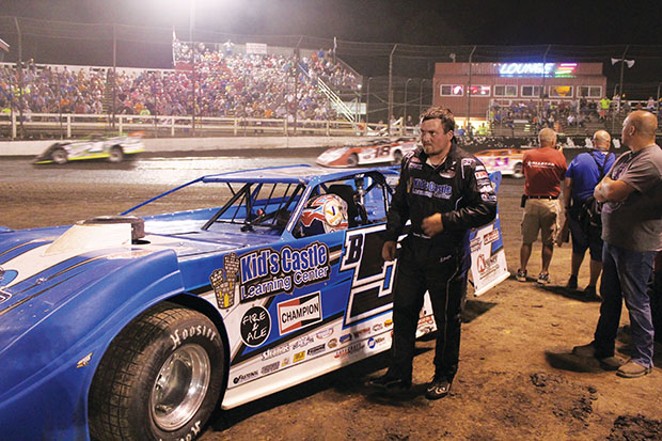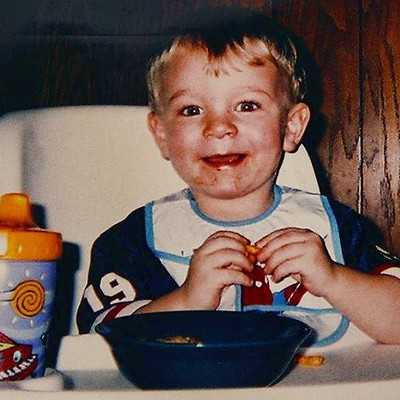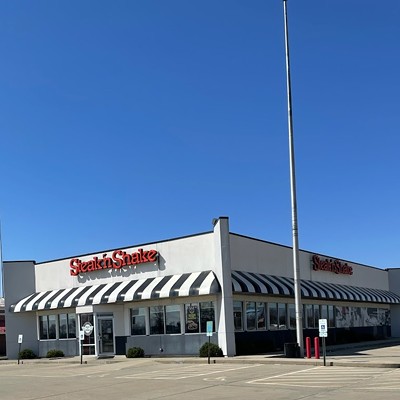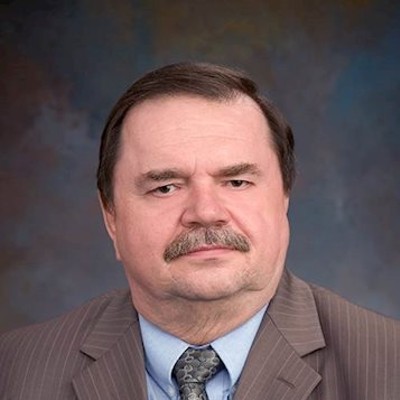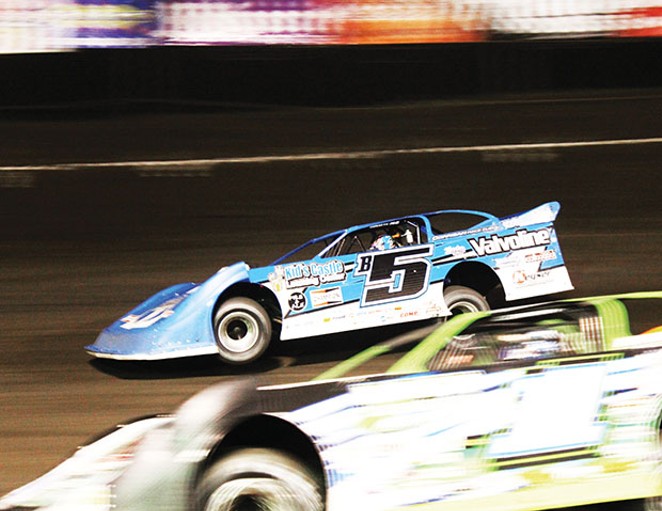
Yeah, Roy so cool,
That racing fool, he don’t know what fear’s about.
He do 130 mile an hour, smiling at the camera
With a toothpick in his mouth.
– Jim Croce
Before the evening’s first green flag at Macon Speedway near Decatur, Brandon Sheppard wipes down his race car.
The vehicle looks more a cross between a Civil War ironclad and Star Wars fighter than a car. It is, in the world of racing, a stock car, at least technically, but looks nothing like a Ford or Chevy save for its size, which is that of a full-fledged sedan. There is no windshield and just one seat. The cockpit resembles a manhole cut from surrounding metal, just enough room for the driver’s head to poke through. Nothing much more, really, than a roll cage, wheels, 800-plus horsepower motor and suspension made for banked dirt courses, some smaller than a high school running track, populated by two dozen or so racers traveling freeway speed or better.
The sheet metal body provides plenty of space for sponsor stickers but otherwise seems superfluous. In an hour, it will be spattered with dirt. By night’s end, it will be torn and scarred, large sections rubbed clear through to gleaming aluminum, a byproduct of going fender-to-fender in two-wide turns where the curious physics of racing on dirt require drivers to turn right to go left, three wheels touching earth in controlled slides that leave the left front tire spinning lazily in the air until halfway down laughingly short straightaways – pauses in turns, really – on this track 45 miles east of Springfield that measures one-fifth of a mile.
“You can go to any other track in the country and you can fit this inside it,” observes Sheppard, who first raced this oval a decade ago, when he was 14.
If you can race here, they say, you can hold your own anywhere. Once racing begins, dirt will fly everywhere, including the grandstand, where it gets deep into hair and inside clothing and makes it impossible to drink from cups. The near-white cement wall surrounding the track is quickly caked to the point that crews scrape away dark-chocolate loam between races so that drivers can discern the difference between soft dirt and disaster. If you’re doing it right, you’re coming within inches of that wall, according to proponents of the high side, Sheppard being one. They call it the cushion, the place where dirt piles up after being thrown outward by cars sliding in the middle and near the infield. Going high on the track, fans and drivers say, is the best way to keep momentum and gain traction, never mind that the low side offers a shorter trip to the finish line.
Given all this dirt, why does Sheppard wipe down his car, which already looks plenty clean, before heading to the track in hopes of winning tonight’s $12,000 purse? It doesn’t appear to be nervous energy – he’s already yawned his way through a driver’s meeting. Perhaps the aerosol spray with a sickly sweet petroleum odor that he’s rubbing in with a rag makes the car a bit slicker and so helps shed dirt – after all, the less weight the better. Or maybe it’s a love for machinery that he has learned to master.
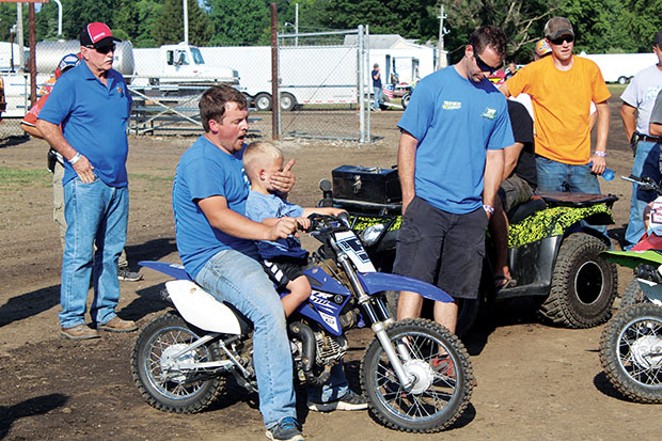
There’s also family to consider. Sheppard is a fourth-generation race car driver, and smart money says that his three-year-old son Jase, who rides double as his father putts around the pits on a small motorcycle, will follow in his tracks. Most of Sheppard’s races are run in a team-owned car, but his ride tonight is owned by his grandfather. He grew up watching his father and grandfather race dirt track, but never with as much success as he’s enjoyed.
“Honestly, I don’t get to race around my family a lot,” Sheppard says. “I wouldn’t do it if I wasn’t trying to make them proud. I don’t do it for me.”
“He’s becoming a superstar”
At 24, Sheppard is becoming the king of late-model dirt car racing, with “late model” signifying the latest in design and technology.
Through the end of July, the New Berlin native has notched 22 victories, including a streak of five in a row that lasted from June 30 through July 4. He races as many as five days a week and sticks mostly to the World of Outlaws circuit, a series of more than 50 races sponsored by Craftsman Tools and held on tracks in 20 states, plus Canada. Fans pay $30 for tickets and an equal amount for pit passes to witness what many consider the top echelon of dirt car racing.
“It’s grueling,” Sheppard says. “It takes a lot out of a guy to drive all night to the next track.”
Sheppard won’t get NASCAR rich – while he’s surpassed $200,000 in winnings so far this year, purses are split with the team’s owner, who provides the car, mechanics and transportation between races while hustling up sufficient sponsors to make ends meet. Although his name is plastered on t-shirts sold trackside, Sheppard’s face won’t cause many double takes at Walmart. But it’s a living that comes with the privilege of not needing a day job and being able to say that you are a professional race car driver, even if you have to help change tires in the pits.
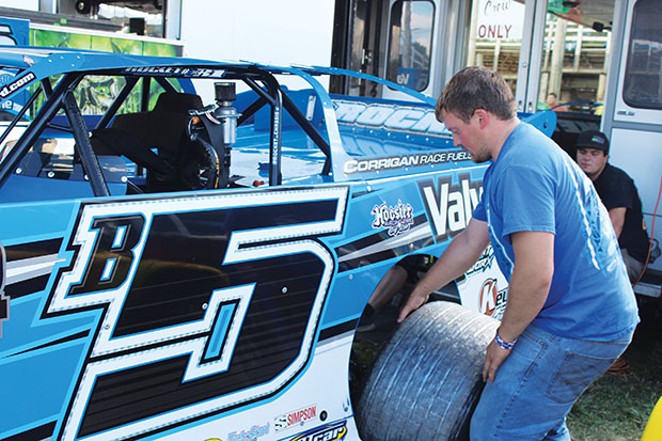
“If you’re looking at making a living as a race car driver, Brandon’s in a pretty good position,” says Mark Richards, team owner. “He has a chance to make some money here, some pretty good money, for the next how-many years – he’s good for at least 20, I’m sure, if nothing happens to him and he stays healthy and everything. There are guys out there doing this who are in their 50s.”
Sheppard has won before. Last October, he captured his second Dirt Track World Championship race in Ohio, nabbing a $100,000 purse for his biggest win ever, uncharacteristically sticking to the track’s low side while the runner-up ran high during a race that didn’t prove close. He also won the championship in 2012. But he’s never taken so many checkered flags in a year as he has this season, which started in February and will wind up in November.
“This is the season he’s becoming a superstar,” says Kevin Kovac, a senior writer with dirtondirt.com, a website devoted to dirt track racing.
Even when he doesn’t win, Sheppard excites. After winning a consolation race in Nebraska last month, he had a choice: Take home a $3,000 prize or start in the back row of the main event, which paid $53,000 to the winner. For Sheppard and his team, it was an easy call.
“That (the consolation prize) is not an option for this team – we’re here to win the race, so if we’ve got a chance to race, we’re going to race,” says Richards. “There’s a lot of things involved. There’s sponsors involved, and we’re here to represent them. The $3,000 is fine, but we’re looking at $53,000.”
Starting in 32nd place, Sheppard picked his way through the field and ended up taking second place. “He got up to fifth, and you could tell: He was going to do what he’s got to do,” recalls Kovac. Richards said he believes that Sheppard would have won if not for a caution flag with 11 laps to go. After the caution, the winner, Richards says, started taking the same line around the track as Sheppard, who lost by less than a second, according to the write-up on dirtondirt.com, which called Sheppard’s effort a “fairy tale run.”
“The kid’s got big balls, man,” winner Tim McCreadie told the website after taking the checkered flag. “He came from dead last and gave it a shot.”
There is plenty of pressure. Racing is a business for Richards, who owns Rocket Chassis, a West Virginia company that manufactures chassis for race cars.
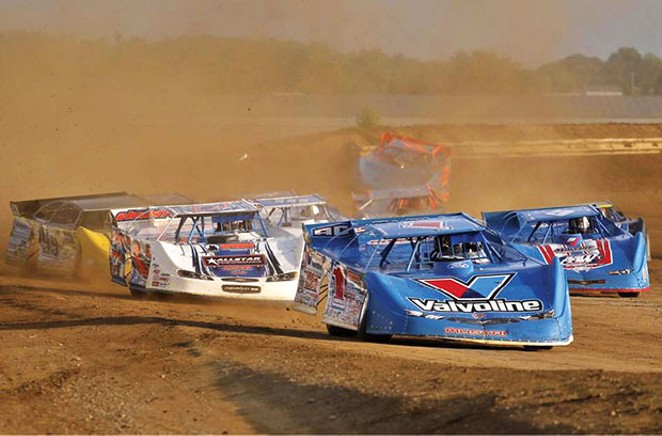
“If this car wins, we sell race cars at Rocket Chassis,” Richards says. This is also our research-and-development team – we research and test any new parts with this team. We also gather information that we pass on to our customers. We need it to make sense, too – it has to make financial sense. We need to win races.”
For all the technology, dirt track remains very much a human endeavor. Speed records at many dirt tracks have lasted for decades. “Tires and shocks and motors are better today, but yet, a lot of the old track records still stand,” says Terry Young, general manager of Hoosier Tire Midwest, a racing tire supplier, and a member of the Springfield Metropolitan Exposition and Auditorium Authority board. “You reach a point where you just can’t get any faster.”
Confident, not cocky
Dirt car racing is not without risk. Two late-model drivers died after crashes last year, one shortly after a horrific fire on the track. And so some degree of nerve, confidence, courage – call it what you will – is necessary to succeed, or even try.
“I don’t think it’s nerve as much as it is confidence,” Richards says. “If nerves are bothering you doing this, you shouldn’t do it. When you climb in, you look at the risk you’re taking, or you should.”
Kovac says that you can just tell with some drivers.
“They can step on the gas and they’re not afraid,” he says. “Brandon’s only 24, but he’s going to be good for a long time. … He’s confident, but he’s not cocky.”
Before and after races, Sheppard appears unflappable. Asked to deconstruct a victory, he will typically break down the race into segments – first this happened, then that happened – talk about tires and other equipment for a bit, praise his crew, thank his sponsors, then head back to the pits with all the emotion of a fellow who has just been asked to describe his day as a certified public accountant. The lack of emotion can drive his father Steve nuts.
In February, Sheppard eked out a thriller in Florida, going from third place with two laps remaining in a 50-lap event to win by a half-car, coming around the outside to pull ahead on the final turn while the crowd roared and the announcer screamed his name.
“We just had a little luck on our side and we were fortunate to have a good race car and we’re thankful,” he said, almost flatly, during a post-race interview conducted with the barest of smiles.
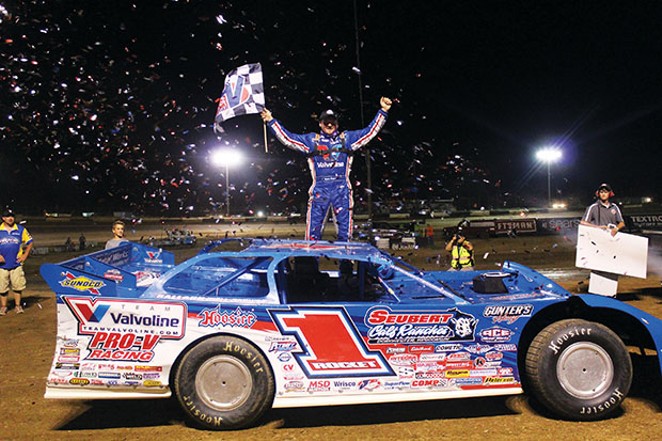
“I’m like, ‘Man, what is wrong with you?’” Steve Sheppard recalls of his son’s post-race demeanor. “You just pulled off the move of the year. That’s going to be considered the race of the year. That was the move of a lifetime. There was no emotion. I asked him, ‘Why weren’t you excited?’ He said ‘I was excited.’ I said, ‘You couldn’t tell.’”
Richards says the younger Sheppard is the most humble driver he’s seen in victory lane. “A lot of young guys in this business, they get overwhelmed with the notoriety, or the perception of them being a winner, and they forget about, hey, tomorrow’s another day, and we’ve got to go do it again,” the team owner says. “That race is behind you. Do the pictures, get it over with and we need to worry about the next one.”
It’s the sort of focus that Steven Sheppard, Sr., Brandon’s grandfather, encouraged years ago, when the boy, not yet in high school, was tempted to play football. His grandfather told him that he was willing to foot the bill for a very expensive pastime, but the boy had to choose between football and the track.
“I hated to do that to him, but if you want to be good at something, you’ve got to do that – you can’t do everything, you know what I mean,” the grandfather says. “I said, ‘If we’re going to do this, and you’re going to do this, and you want me to spend the money, the only thing I can tell you is we have to do it right and it can’t be a fly-by-night thing.”
A humbling sport
Steve Sheppard, Jr.’s racing career overlapped a bit with his son’s. “When he started beating me, that’s when I decided to hang it up,” the father says. Like his son, the elder Sheppard favored the high side, where cars slide close to the wall. “Racing’s very physical – when you run the high side, it’s demanding,” Steve Sheppard says. “You’ve got to be so precise to run the high side.”
Aside from preferring to race near the wall, the son drives nothing like the father did. Steve Sheppard had a reputation for full-on, aggressive driving. He is legendary for once stomping the hood of a car that pushed him into the wall of a straightaway, knocking him out of the race. The hood gave way like only a piece of sheet metal can when jumped on by a full-grown man. After destroying the hood, he went for the driver, who remained in the cockpit as race officials tackled Sheppard and took him to the ground. He cannot imagine such an outburst from his son, whom he says has had just one speeding ticket since turning 16.
“He don’t have the temperament for that,” the elder Sheppard says. “I’m very hot-headed, and I think he learned from me not to be. … He’s a very respectful driver. He won’t go and slam into the side of someone to get to a certain position. I wouldn’t be afraid of doing that at all, if that’s what I needed to do.”
Richards first saw Brandon Sheppard race at a track in Lincoln when he was 13 or 14. “You could just tell he had it,” Richards said. “I said ‘Who’s that in the five car?’ That’s when I started watching him.”
Sheppard says that he hasn’t always been comfortable in a race car. “At the beginning of my career, I was always really nervous,” he says. “I tried to stay out of people’s way and earn respect.” Even now, he’s known as a finesse driver who doesn’t force things. “You’ve got to be patient for 100 laps,” he says.
“Patience is what he has, and a lot of drivers don’t,” the elder Sheppard says. “I ask him, ‘Why don’t you drive harder?’ He says, ‘Dad, if the car’s fast enough, be patient, and it will come to you.’”
Smooth – that’s what they call Sheppard’s style of racing, the sort of driving that’s easy on tires so they’ll grip when you need them in the late going. “He runs hard, but he doesn’t burn his stuff up,” Young says.
A July 26 race at the Fayette County fairgrounds in Brownstown, about 80 miles southeast of Springfield, was classic Sheppard. He took the lead on the first lap of the 40-lap contest, staying high, keeping his speed consistent and gaining as much as a straightaway on his closest competitor. But a yellow caution flag – they can be frequent as cars spin out or break down – with four laps to go proved an equalizer as the field bunched up for the restart.
While Sheppard remained high on the track, Chris Madden, a driver from South Carolina, found traction near the infield and nearly pulled even in a battle for first. On the final turn, a sliding Sheppard kisses the wall with his right rear quarter panel – surely Madden would best him now. But it was an “excuse me” touch, just enough to cause a slight fishtail but not hard enough to break momentum. Sheppard’s official margin of victory was less than four-tenths of a second.
Afterward, he talked about tires – no one, he says, seemed to have the right tires installed. His brush with the wall goes unmentioned. One night earlier in Macon, he talked about the realities of racing as he sat in the pits, waiting for the evening’s first heat. Sure, he’d won a lot of races, he acknowledged. But anything, he notes, can happen on the track.
“It’s really a humbling sport,” he says. He runs near the front for the first half of the 100-lap main event, but is forced out on the 77th lap due to a busted shock. Humble or no, frustration is evident in Sheppard’s eyes as he climbs from his car, studies the rear suspension, then turns to the track, watching stoically from the infield as cars roar past.
Contact Bruce Rushton at [email protected].

